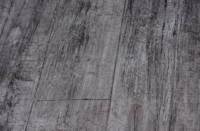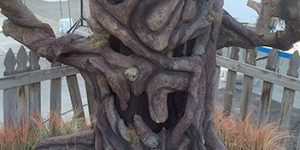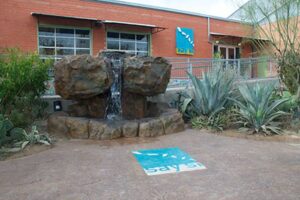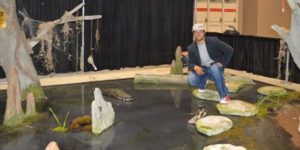At the seventh annual Concrete Decor Show in San Diego, California, world-class instructors and eager students from around the globe joined their talents and enthusiasm to breathe new life into the outdoor surroundings of the Bannister Family House, which provides a home-like environment for people with family members in long-term or critical care at the nearby UC San Diego Health.
Each year, promoters of the Concrete Decor Show choose a nonprofit organization in the show’s host city that will benefit from a makeover to its facilities. With donated materials and their own sweat equity, workshop participants practice newly learned or honed skills in a real-world work environment and leave behind beautiful concrete to brighten people’s lives.
The 2016 recipient, the Bannister Family House, is a facility funded by a generous donation from the late Ralph Bannister and named in honor of his late wife and daughter. It opened in May 1994 and since then, more than 4,000 families from 50 states and 23 countries have enjoyed its comforts. It gives families a place to sleep, to rest during the day, prepare meals, launder clothes, and space where children can play and lead relatively normal daily lives.
Improvements made during the workshops held Sept. 25 and 26 included a bas-relief concrete mural on a large retaining wall, an engraved sidewalk, a built-in barbecue and concrete countertop, a seating wall, carved concrete rock features on a retaining wall, a pattern-stamped patio and a stained tree of life-like design in a courtyard complete with an inlaid LithoMosaic heart.
San Diego-based landscape architect Amanda Conahan and T.B. Penick & Sons created the conceptual design for the Bannister Family House. Crews from T.B. Penick and the Associated General Contractors of San Diego helped with much of the preliminary work.
“When we were first approached to partner with the Concrete Decor Show we could have never imagined the outcome would be as rewarding as it has been,” says Jana Fortune, the Bannister Family House liaison for UC San Diego Health. “Our ‘home away from home’ for families facing a medical crisis has been transformed with outdoor spaces that are truly an oasis for our residents when not at the hospital.”
Fortune says she was impressed with everyone involved with the transformation as they were “conscientious, caring and compassionate” toward the house’s mission and to those it served. Now that the dust has cleared, she says she misses everyone who was there before and during the show and wanted to extend a heartfelt thank you for their time, talent and hard work.
“Concrete Decor Show and its staff are class acts and anyone affiliated with the show should be proud of the lasting mark the industry has left at the Bannister Family House and all of the families it will house in the future,” Fortune says.
It is estimated that the Concrete Decor Show’s in-kind gift to The Bannister Family House exceeds $250,000.
The following workshops were held to makeover the Bannister Family House:
Creating Outdoor Elegance with Concrete Stains Trainer: Rick Lobdell, Concrete Mystique
In the courtyard at the Bannister Family House, master designer and artisan Rick Lobdell led a class that showcased ways that design and minimalist use of color can create an outdoor sanctuary for hospital visitors who seek quiet reflection, solitude or family time.
Without the use of stencils, students explored how to create beauty through the art of free-hand painting with stains. Students learned how to apply color theory to a project using the same basic color at full strength and diluted.
While the design was saw cut ahead of time because of its complexity, Lobdell says, students took part in masking off the design and applying the stain. “We used one color twice to make it look like two different colors,” Lobdell says. “It works really well.”
Lobdell says his students tell him they appreciate the workshops he leads as they are live projects, not demonstrations. Because it is a “live situation,” there are many obstacles that must be handled such as severe weather conditions (it was around 100 degrees F both days), people from other classes walking on the design and having to share common space with others working on projects nearby. Also, real problems may pop up that need to be addressed if the result is going to be a quality floor.
In this workshop, “We had added grit to the urethane to make the surface slip resistant and I wasn’t paying attention when the students were pouring. There was extra grit at the bottom (of the pail) and they just poured it all out.” There were a few hectic moments there, he says, especially with the “temperature way up there.” But he remained calm and quickly scraped up the excess grit while they were mixing the next batch.
“It was a common mistake but most of the students hadn’t seen it before,” he says. “You have to get the urethane perfect or you’ll have complications down the road.” This misstep scared the students, he says, but in a good way. “They got to learn how to handle a mistake when it happens on a real job. They really appreciated that.”
Westcoat donated the water-based stains and urethane for this workshop.
Stamped Overlays for Public Spaces Trainer: Julio Hallack, Concrete By Hallack
Julio Hallack led this workshop that showed the attendees the different steps involved with successfully mixing, placing, staining and sealing a quarter- to half-inch stampable overlay. The session included surface preparation and installing a primer, and covered the importance of dealing with crack repairs, and control and moving joints because, as Hallack says, “Not all the joints are the same.”
“The area where we worked was at times challenging due to the access and being so close to the hill,” Hallack says. Chalk another one up for the real world.
One of the students, C.J. Salzano of Salzano Custom Concrete in Centreville, Virginia, had attended workshops at two prior Concrete Decor Shows. He says he took this one because his company performs stamped overlay work, and he had some specific questions about some installation challenges he wanted to talk to Hallack about. “I wanted to get Julio’s ideas and watch his technique,” he says.
The thing he liked best about the workshop was seeing someone else demonstrate proper procedures on a live project. To him, that was the most valuable take-away he got from attending this workshop, which he recommends to colleagues.
Westcoat donated most of the products used for this project. Hi-Tech Systems donated the two-part polyurea to fill in the moving joints and cracks. Proline stamps were used.
Concrete Countertop Fabrication from Start to Finish Trainer: Del Turley, ElastoCrete
Participants helped create a concrete countertop and sitting wall caps and put the finishing touches on a built-in barbecue installed earlier by a crew from T.B. Penick & Sons. The basics of building a successful concrete countertop was demonstrated, including mold making, mixing, placing cement, staining and sealing with water-based acrylics.
Workshop products were donated by ElastoCrete.

From Concept to Completion: Bas-relief Public Mural Trainer: Cindee Lundin, The Studio by Cindee Lundin
Under the watchful eyes of Cindee Lundin, participants helped to create a bas-relief public mural at the Bannister Family House. Titled the “Ebb and Flow of Life,” the mural was created by integrating concrete with texturing, sculpting, coloring and design techniques.
It was a busy two days for the bas-relief participants, as most stayed until 8 p.m. to help apply, color, texture and carve the design on an existing exterior concrete wall using a vertical concrete mix. They also colored and helped install detailed elements made prior to the show.
According to Lundin, “The design depicts the ebb and flow of our lives that go forward in the waves then are suddenly shattered by an event.” The doves, 40 in all, symbolize love and hopefulness taking flight after a fall, she says, and the feathers engraved on the walkway represent the little pieces we leave behind. Yet, through it all, “We are still able to fly.”
Lydia Phillips of Murals, Mosaics and More by Lydia in La Mesa, California, had never worked with concrete before and took the class to learn a new technique. A muralist by trade, she says Lundin’s project showed her how versatile concrete can be but, more importantly, “I learned that circumstances are not always under your control and that troubleshooting is part of what happens in a real-world project.”
Scott Harrington of Harrington Homes in Eagar, Arizona, says he took the class to “explore the artistic side” of concrete even though he’s a general contractor. He says he learned “lots of different pieces, which made for good (if somewhat long) training.”
“Cindee covered a lot of different materials, techniques and dealing with unforeseen problems on the fly,” he says. It was a very ambitious project, but in the end, “It was finished and looked great.”
Workshop products were supplied by Stone Edge Surfaces (formerly Flex-C-Ment), EZChem Inc. and Polytek Development Corp.
Sculpting Rock Features for the Ultimate Courtyard Trainers: Troy Lemon, Cornerstone Decorative Concrete; Warren Ness, Rock Sculptor

In this “rockin’” workshop, attendees learned how to use vertical carving mixes to sculpt a stone facade for a large-scale retaining wall in the Bannister Family House courtyard. Workshop instructors Troy Lemon and Warren Ness shared their experience and technical know-how to help participants learn new tricks of the trade for carving, texturing and coloring concrete to make it look like natural boulders and chiseled stone.

Ness headed up the boulder-making segment of the workshop, which included coloring as well as carving. Besides including greenish “moss-covered” areas on the faux rocks, Ness demonstrated on a massive rock “outcropping” how to create realistic-looking lichens, simple slow-growing greyish plants that often grow on rocks. As a finishing touch, students eagerly created their own.

In addition to placing and carving stonework on the retaining wall, Lemon and a group of students created a free-standing wall that initially was meant to serve as a practice piece that would be destroyed at workshop’s end. UC San Diego Health representatives asked if they could keep that impromptu piece of decorative concrete— which was a mix of faux dry stack limestone, wood planks and metal fasteners— and move it elsewhere on the property. Lemon and his team gladly agreed, and even included the hospital’s name on the front.

Stone Edge Surfaces (formerly Flex-C-Ment) donated the mix for stone making. Brickform and CTS Cement Manufacturing Corp. also donated products.




























